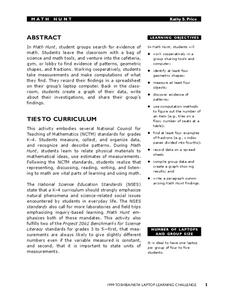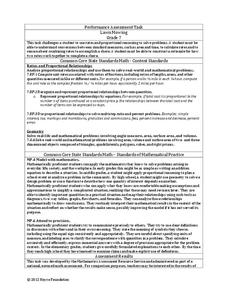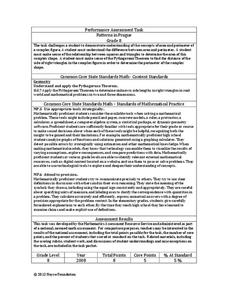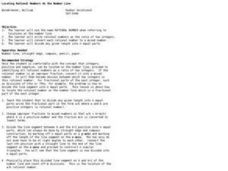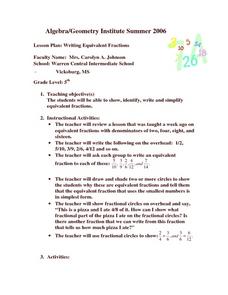Cornell University
Beam Focusing Using Lenses
Explore optics using an inquiry-based experimental approach! Young scholars use a set of materials to design and build a unit capable of focusing a beam of light. They experiment with different lenses to determine the best approach to...
Curated OER
Palace Adventure
Young language arts learners write and illustrate a short fantasy story based on the book Corduroy. First, learners need to develop a character. Then, through their writing and illustrations, they take their characters on adventures...
Curated OER
Plate Tectonics Day 4 Earth's Interior Structure and Convection Currents
Young scholars introduced to the interior structure of the Earth. They explore how the Earth's interior is broken down according to both it's physical properties and it's chemical composition. Students explore how convection currents...
Curated OER
Math Hunt
Go on a scavenger hunt around your school to find evidence of math. Investigate different areas of your school for patterns, fractions, and different geometric shapes. Finally, create a spreadsheet and plot the data you've collected.
Curated OER
Hatchet: Concept Analysis
Take an in-depth look into Gary Paulsen's Hatchet with a concept guide. With a list and explanation of thematic motifs, types of conflicts, and vocabulary in the novel, learners will engage with the text in a whole new way.
Noyce Foundation
Lawn Mowing
This is how long we mow the lawn together. The assessment requires the class to work with combining ratios and proportional reasoning. Pupils determine the unit rate of mowers and calculate the time required to mow a lawn if they work...
Inside Mathematics
Patterns in Prague
Designers in Prague are not diagonally challenged. The mini-assessment provides a complex pattern made from blocks. Individuals use the pattern to find the area and perimeter of the design. To find the perimeter, they use the Pythagorean...
EngageNY
Finding a Rate by Dividing Two Quantities
Develop the right station to solve rate word problems. The 18th instructional activity in a series of 29 starts by interpreting the aspects of rates with two different quantities. Pupils use the interpretation of rates to solve problems,...
Smithsonian Institution
Western Indian Wars
Why do many Native Americans live on reservations? An interactive resource teaches about how reservations came to be and the tragic history behind Native Americans moving from their lands. Teenagers read passages, view images, and click...
Florida Center for Reading Research
Vocabulary: Word Meaning, Defining Depictions
A picture is worth a thousand words! Young learners use the included templates to demonstrate their understanding of target vocabulary by creating pictures that depict their meaning.
Education Development Center
Area Model Factoring
Introduce learners to what factoring represents and it's relationship to a square with a resource about factoring and the method of area models. The questions are scaffolded to begin with introductory questions and eventually have...
Curated OER
Play Dough Pizza Party
Students review fractions using a visual display. They receive a can of Play Dough and have to complete a worksheet figuring out how to divide up a pizza for a specified number of guests.
Curated OER
Comparing and Ordering Fractions
Third graders create fractions from concrete materials, then use paper fractions.
Curated OER
Giggle, Giggle, Quack Pizza Fractions
Students explore the concept of multiplication by using pizza. They read an article discussing how math is used everyday. They try to determine how many pizzas they would need to feed the class.
Curated OER
Locating Rational Numbers on the Number Line
Students explore the concept of locating rational numbers on a number line. For this rational numbers lesson, students change improper fractions to mixed numbers to determine where on a number line the rational number belongs. Students...
Curated OER
Writing Equivalent Fractions
Fifth graders work to find the fractions that are equal to one another. They use a visual pie graph to show different values. Students are able to see how fractions can look different, yet have the same value.
Curated OER
Informational Reading: Electronics Are Made from Resources
In this comprehension learning exercise, students read about the making of a computer: circuit boards, hard drives, monitors and plastic housings. Students then answer 3 multiples choice questions.
Curated OER
Technology has a Solution!
In this technology instructional activity, learners summarize four things they learned about technology and the environment. Students then write a report that outlines how technology is solving environmental issues.
Curated OER
A Look at the Life That Electronics Lead
For this comprehension worksheet, students fill in ways on a graphic organizer that people or companies can conserve energy, reduce waste or minimize the impact to the environment. Next, students solve 3 "environmental" math word problems.
Curated OER
It Ain't Easy Being Green!
Students explore the needs of plants. In this science lesson plan, students plant seeds and place one in a sunny spot and the other in a dark area. Students observe what happens.
Curated OER
Rehearsal and Sightreading Techniques
Eighth graders prepare the two pieces "American Celebration" and "Patriotic Bits and Pieces" for an upcoming performance. This lesson is a forty-five minute lesson geared towards a middle school advanced band (8th Grade). National and...
Curated OER
All About Me
Students examine who they are through the arts and sciences. They create a portfolio entitled, " All About Me."
Curated OER
Orienteering - The Fundamentals
Students investigate the concept of a compass and it has been used in the past and in modern times. They practice using it in the wilderness in order to test its importance in various exploring activities. Each activity is accompanied by...
Curated OER
Making Pretzels
Students explore how people use plants for food. They use pretzels to see how wheat can be turned into food.



